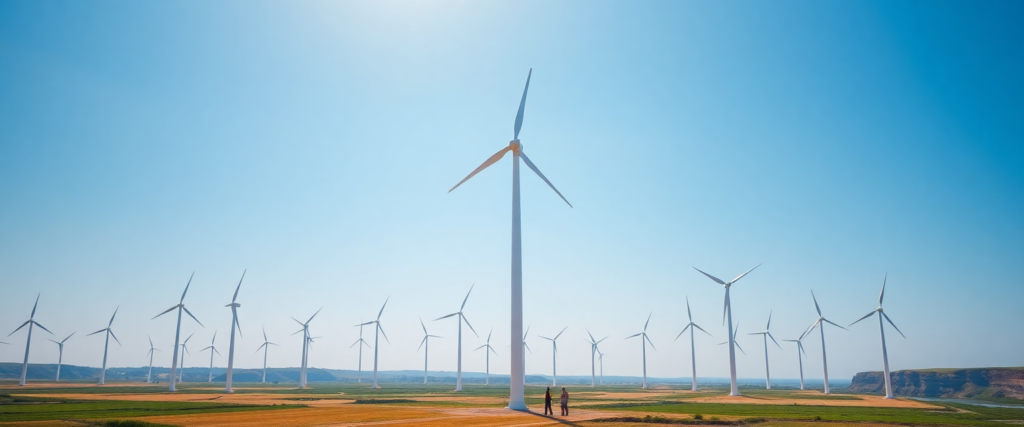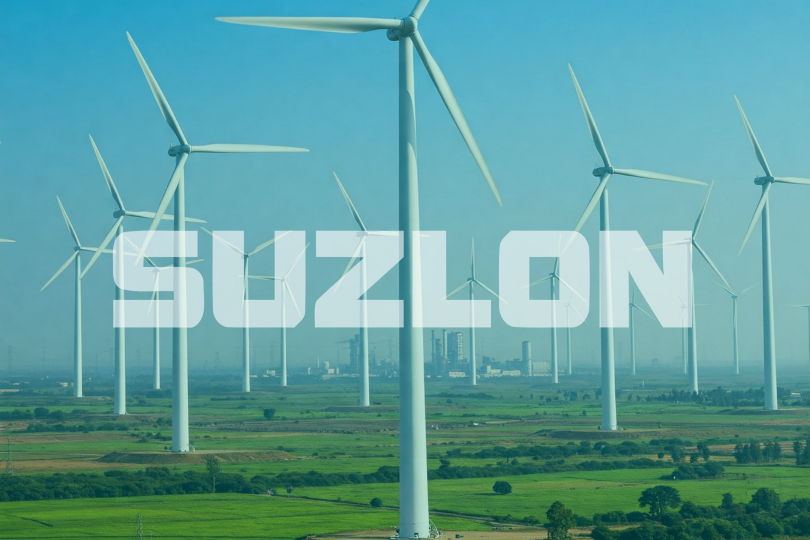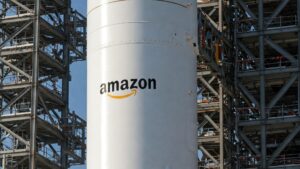You know how sometimes the most annoying problems lead to the biggest opportunities? That’s exactly what happened with Tulsi Tanti. Back in the 90s, this guy was running a textile business in Gujarat, India, and was absolutely fed up with constant power outages and electricity bills that were eating his profits alive. Instead of just complaining (like most of us would!), he actually did something about it.
And that “something” turned into Suzlon Energy – one of India’s most fascinating business stories and a company that helped put India on the global renewable energy map. So grab your favorite beverage and let me tell you how a power-starved textile businessman ended up building one of the world’s largest wind energy companies.
The Lightbulb Moment (or Should We Say… Wind Turbine Moment?)
It’s 1995. The internet is barely a thing. Most people haven’t even heard of climate change. And Tulsi Tanti is pulling his hair out because power cuts keep shutting down his textile machinery in Gujarat.
Electricity was eating up about 40% of his production costs – insane, right? After exploring options, he installed two wind turbines to power his textile factory. Not only did this fix his power problems, but it also delivered a serious “aha moment” – if he needed reliable, affordable power, other Indian businesses probably did too!
In a move that probably had his family questioning his sanity, Tanti sold off his perfectly good textile business and went all-in on wind energy. Suzlon Energy was born with a modest $600,000 investment and an immodest ambition to transform India’s energy landscape.
I love this part of Suzlon’s story because it’s so relatable. We’ve all had those moments where we think, “There’s got to be a better way!” The difference is, Tanti actually built that better way instead of just daydreaming about it like I do when stuck in traffic.
From Zero to Hero: Building a Wind Company Without a Roadmap

Starting a wind energy company in mid-90s India was about as straightforward as trying to build a spaceship in your backyard. There was no ecosystem, no supply chain, and practically no one who knew anything about wind turbines.
But Tanti was no dummy. Instead of trying to design turbines from scratch (which would have been financial suicide), Suzlon licensed technology from a German company called Südwind. Smart move! They started by assembling imported parts while gradually building their own manufacturing capabilities.
By 1998, they’d installed their first wind turbine. By 2001, they had their first manufacturing plant in India. And by 2003, they were already expanding internationally. Talk about not letting the grass grow under your feet!
What I find super clever about their early approach was how they turned India’s challenges into strengths. When foreign competitors complained about India’s infrastructure, Suzlon designed turbines specifically for Indian conditions – machines that could handle insane heat, deal with grid instability, and be transported on terrible roads.
It’s like they embraced the “This is India!” reality instead of fighting it. There’s probably a life lesson in there somewhere…
Suzlon’s Secret Weapon: Making Wind Energy Stupid Simple
If you’ve ever tried to assemble IKEA furniture without instructions, you’ll appreciate what Suzlon did next. Instead of selling just turbines (like most manufacturers), they created an all-in-one package that handled literally everything: finding the right location, measuring wind speeds, helping secure financing, manufacturing the turbines, installing them, and providing long-term maintenance.
This “concept-to-commissioning” approach was brilliant for emerging markets where customers had zero experience with wind energy. It removed all the barriers and basically said, “Don’t worry about how it works – we’ll handle everything.”
It’s like the difference between buying ingredients to cook a complex meal versus ordering takeout. Suzlon made wind energy “takeout simple” when everyone else was still expecting customers to figure out the recipe themselves.
Riding the Wind to Global Success

By the mid-2000s, Suzlon was absolutely crushing it! Their 2005 IPO raised about $340 million and was massively oversubscribed. By 2006, they’d somehow climbed to become the 5th largest wind turbine maker IN THE WORLD. Like, what?! A company from India that most people couldn’t even pronounce was now going toe-to-toe with global engineering giants.
In 2007, they made a move that left the business world with their jaws on the floor – they acquired German manufacturer REpower (later renamed Senvion) for a mind-boggling €1.4 billion, followed by Belgian gearbox maker Hansen Transmissions.
At their peak around 2008-2009, they controlled roughly 10% of the global wind energy market. For a company that started just a decade earlier in India, that’s not just impressive – it’s borderline ridiculous.
I remember reading about these acquisitions in business school and thinking it was a typo. An Indian company buying established European engineering firms? This was happening when the standard narrative was still about Western companies acquiring businesses in developing economies – not the reverse. Suzlon was flipping the script in spectacular fashion.
When Everything That Could Go Wrong… Did Go Wrong
But here’s where things get real. Success in business often plants the seeds of future problems, and boy did Suzlon plant a forest.
Their aggressive global expansion left them with mountains of debt just as the 2008 financial crisis hit like a wrecking ball. Suddenly, project financing evaporated, orders were canceled left and right, and Suzlon found itself in the corporate equivalent of quicksand – massive debt and shrinking revenue.
As if that wasn’t bad enough, some of their turbines started experiencing technical problems, including some highly publicized blade failures in the U.S. market. Nothing kills confidence in a wind turbine company faster than blades breaking off. (Pro tip: wind turbine blades should generally stay attached to the turbine!)
By 2012, Suzlon defaulted on convertible bonds worth $221 million – at that time, the largest such default by an Indian company ever. The poster child of Indian renewable energy was now fighting just to survive.
What happened? In hindsight, it was classic entrepreneurial overreach. They tried to go from local player to global powerhouse too quickly. Their massive acquisition debt left zero margin for error. And perhaps most importantly, they lost focus on their core strength – providing reliable, appropriate technology for emerging markets – as they chased global market share.
It’s like watching someone try to run a marathon after just learning to jog. The ambition was admirable, but the body just wasn’t ready for that level of stress.
Picking Up the Pieces
The last decade has been a humbling journey of restructuring and rebuilding for Suzlon. They sold off their expensive European acquisitions – Hansen Transmissions in 2011 and Senvion in 2015. They went through corporate debt restructuring (a nice way of saying “please don’t make us go bankrupt”) and have been working to slim down, refocus on India, and rebuild their reputation.
Founder Tulsi Tanti stuck with the company through its darkest hours until his passing in 2022. Despite financial chaos, Suzlon kept innovating with new turbine models and maintained significant market share in India.
By returning to their home market – where they actually understand the conditions and have strong relationships – they’ve been slowly stabilizing. India’s ambitious renewable energy targets (they’re aiming for 500 GW of non-fossil capacity by 2030) have created a supportive environment for their recovery.
In 2022, after years of struggle, Suzlon completed another round of debt restructuring and raised fresh capital through a rights issue. They’re not out of the woods yet, but they’re at least on a path instead of being lost in the forest.
What I find genuinely inspiring about this chapter is their sheer persistence. Most companies would have collapsed under the weight of their problems, but Suzlon has been fighting year after year to survive. It’s like watching Rocky Balboa getting knocked down repeatedly but somehow still getting back up.
What Can We Learn From All This?
If you’re an entrepreneur or innovator, Suzlon’s wild ride offers some pretty valuable lessons:
Solve your own headaches first. Tanti started by fixing his own power problems before realizing it could be a business. The best ideas often come from scratching your own itch rather than trying to solve theoretical problems.
Don’t be intimidated by established industries. When Suzlon started, wind energy was dominated by European and American giants. Being the new kid on the block didn’t stop them from becoming a serious player.
Adapt global tech to local realities. A huge part of Suzlon’s initial success came from making wind technology work for India’s specific conditions. Sometimes the biggest innovation isn’t inventing something new – it’s adapting existing technology to work in new contexts.
Ambition is good. Reckless ambition is dangerous. Suzlon’s aggressive global expansion nearly destroyed the company. There’s a fine line between bold moves and foolhardy ones, especially when debt is involved.
Resilience matters more than initial success. Honestly, Suzlon’s most impressive achievement might not be their meteoric rise, but their refusal to die when everything went sideways. They’ve spent more years clawing their way back than they spent as a high-flying success.
Timing is everything. Suzlon caught the first wave of renewable energy enthusiasm, then got hammered by the global financial crisis. Today, they’re positioning for the much larger second wave of climate-focused investment. Sometimes being right too early can be just as painful as being wrong.
Where Are We Now?
The wind energy world that Suzlon helped pioneer has transformed beyond recognition. What was once seen as an alternative energy experiment has become mainstream – often cheaper than fossil fuels without subsidies (something that seemed impossible when Suzlon started).
Massive players like Vestas, GE, and Siemens Gamesa dominate with turbines that are engineering marvels. Chinese manufacturers have stormed the market with lower-cost options. The whole industry has consolidated, matured, and industrialized in ways that would have been hard to imagine in the 90s.
And yet, Suzlon’s contribution remains meaningful. They weren’t just building a company – they were helping create an industry that’s now central to addressing climate change. Despite all their troubles, they’ve installed over 19 GW of wind capacity globally – that’s enough to power millions of homes with clean electricity.
Looking Forward: Can They Catch the Wind Again?
Today’s Suzlon is a humbler company than the global high-flyer of 2008, but perhaps a wiser one too. With India’s renewable energy market booming and their debt burden reduced, they have a fighting chance at sustainable success.
They’re now focused on larger, more efficient turbines, repowering older wind farms with new technology, and hybrid wind-solar projects. These are sensible strategies that play to their strengths while adapting to where the market is headed.
For anyone following Suzlon as a case study, perhaps the biggest lesson is about timing and market selection. Tulsi Tanti’s core insight – that renewable energy would become increasingly important – was absolutely right. The challenge was navigating the inevitable ups and downs of a new industry while managing growth responsibly.
As we face the urgent reality of climate change, companies like Suzlon remind us that building sustainable businesses in clean energy isn’t just about technology and profits – it’s about persistence, adaptation, and playing the long game. The energy transition is a marathon, not a sprint, and the companies that succeed will be those that can weather the inevitable storms while keeping their eyes on the horizon.
In the end, Suzlon’s story isn’t just about wind turbines – it’s about dreaming big, taking risks, learning from failures, and the messy, non-linear journey of trying to build something meaningful in a rapidly changing world. For anyone looking to make an impact, there are few business stories more instructive – in both triumph and disaster – than Suzlon Energy.
References
- Suzlon Energy Official Website: https://www.suzlon.com/
- Suzlon – Wikipedia
https://en.wikipedia.org/wiki/Suzlon - “Against the Wind: Suzlon Energy’s Journey” – Business Today Profile: https://www.businesstoday.in/magazine/features/story/suzlon-energy-journey-tulsi-tanti-328741-2022-10-02
- “Tulsi Tanti: The Wind Man of India” – Forbes India https://www.forbesindia.com/article/leadership/tulsi-tanti-the-wind-man-of-india/78335/1
- BloombergNEF Renewable Energy Investment Trends 2024
https://about.bnef.com/blog/renewable-energy-investment/ - “Suzlon Energy to ride India’s wind boom, says Motilal Oswal, initiates coverage with ‘buy’ tag” – Moneycontrol
https://www.moneycontrol.com/news/business/stocks/suzlon-energy-to-ride-india-s-wind-boom-says-motilal-oswal-initiates-coverage-with-buy-tag-12974418.html










